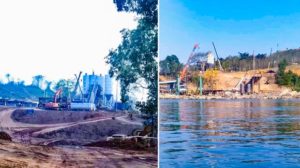
Credit: Citizen journalist
Thai, Chinese backers sign power purchase agreement for Mekong River dam in Laos
Agreement between China’s Sinohydro Corp., Thailand’s Gulf Energy Development Public Co., Ltd., and the Electricity Generating Authority of Thailand (EGAT)
The dam in northern Laos would be the third built on the river in the country.
Thai and Chinese investors have signed a power purchase agreement that paves the way for the construction of a third dam on the Mekong River in Laos.
The project in the Pak Lay district of northern Laos’ Xayaburi province – delayed for several years – could see work on basic infrastructure like a bridge and road access start immediately, according to an official from the Ministry of Energy and Mines.
Construction is scheduled to begin early next year on the main structure, which is expected to be open for business by 2032, the official said.
The agreement between China’s Sinohydro Corp., Thailand’s Gulf Energy Development Public Co., Ltd., and the Electricity Generating Authority of Thailand (EGAT) was signed Wednesday.
The two previous Mekong mainstream dams – the Xayaburi Dam and the Don Sahong Dam – were completed in 2020. The Pak Lay Dam is one of several Mekong River projects in the planning or early construction stages as the government looks to generate revenue by selling the electricity from its hydropower projects to its neighbors, especially Thailand.
Eight villages to be resettled
But there are serious environmental concerns and questions about the economic viability of the major dam buildup. The Mekong is one of the world’s most biodiverse river basins with more than 1,100 species of fish. As the world’s largest inland fishery, the river is a vital food source for the 70 million people in Laos, Thailand, Cambodia and Vietnam who live in its basin.
A Lao conservation official pointed out that Thailand doesn’t really need the extra power generation. It already has more than 15% in reserve, and the Pak Lay project will just add more debt to the Thai public, the official said.
Those working to get the dam built are more interested in helping investors than benefitting the livelihoods of local people, said Om Boun Thipsouna, the chairwoman of seven lower Mekong provinces of Thailand.
“The Mekong River doesn’t just belong to one country,” she said. “It is a common river.”
The project will affect eight villages, with more than 3,500 people expected to be moved to a new settlement, according to an assessment from the dam builder.
One villager from Pak Lay district said most villagers don’t want to move from their villages where they already have land for farming, places to buy food, roads, schools and a temple. No official has come to talk to villagers about relocation and compensation yet, the villager added.
Gulf Energy Development will have a 40% share of the 770 megawatt dam, with Sinohydro taking the remaining 60%. All power will be sold to EGAT, a state-owned enterprise under the supervision of Thailand’s Ministry of Energy and Ministry of Finance, during a 29 year-concession.
Source: https://www.rfa.org/english/news/laos/pak-lay-dam-agreement-03232023164400.html


